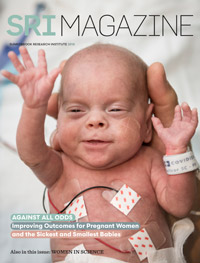Will ultrasound be used one day to diagnose breast cancer?
Inexpensive imaging technique shows high potential to provide early, precise and noninvasive "acoustic" biopsy
In Canada, the average wait time for a breast cancer diagnosis for women who need a biopsy ranges from five to seven weeks. That’s easily more than one month of uncertainty and worry for women and their loved ones.
Imaging scientists in the Odette Cancer Research Program at Sunnybrook Research Institute (SRI) are developing a tool that could give women and their health care providers the answers they need much sooner. Dr. Ali Sadeghi-Naini and Dr. Greg Czarnota, who directs the Odette Cancer Research Program at SRI, led the team that is the first to show that quantitative ultrasound-based imaging can distinguish between benign and cancerous lesions. The paper was published in Scientific Reports.
“One of the benefits of this technique is that it’s almost real time and it’s accessible. Patients usually wait weeks for a biopsy or MRI results, but with this technique we could very quickly triage critical cases,” says lead author Sadeghi-Naini.
In the study, 78 women with suspicious breast lesions were recruited from Sunnybrook. The researchers used quantitative ultrasound, a novel, noninvasive technique they developed, to classify benign lesions and malignant tumours. They compared their results with analyses of biopsy samples done by pathologists and studies of MRI scans done by radiologists. Using a hybrid quantitative ultrasound biomarker, the scientists found they could distinguish between benign and cancerous lesions with more than 90% accuracy.
The technique works by using the raw data generated by ultrasound machines and analyzing features of the ultrasound signal. The abnormal makeup of cancerous tissue tends to result in a higher-intensity signal, notes Sadeghi-Naini. “Tumour cells grow much faster and in an irregular manner. Usually, the cells are dense and very tightly spaced, and the vasculature is very irregular. Potentially, the power of the echo we get from ultrasound is stronger.”
Based on measurements of the return of the ultrasound signal throughout the lesion, the researchers are able to “map” its microstructure, which includes cells and blood vessels. Furthermore, by a method called texture analysis, they can show where in the lesion there are differences in signal characteristics that are based, for example, on changes in the size, density and spacing of suspicious cells, which give the images “texture.”

Scientists at Sunnybrook Research Institute are developing a noninvasive ultrasound-based tool that aims to expedite cancer diagnosis.
Dr. Belinda Curpen, a radiologist at Sunnybrook and a co-author of the study, notes that women with a breast lump normally undergo mammography, ultrasound and, if necessary, a biopsy. For women who come to Sunnybrook and are not in the Rapid Diagnostic Unit, where those suspected of having breast cancer get a diagnosis one day after testing, it can take about a month to find out whether a lump is cancerous. Quantitative ultrasound-based imaging could improve efficiency. “We would be able to tell without doing a biopsy if something is malignant or not. We could reduce a lot of the biopsies that we’re doing for lesions that are obviously benign on quantitative ultrasound,” says Curpen, who says larger trials are needed before the technology can be adopted clinically, trials that Sadeghi-Naini notes are “a few years” away.
The goal, says Dr. William Tran, a scientist at SRI and a co-author of the study, is to be able to characterize different tissue types noninvasively. “That’s really what we’re chasing with this technique: high accuracy, high sensitivity and high specificity ‘acoustic’ biopsy in place of traditional pathological [needle] biopsy.”
Knowing right away if a tumour is malignant would expedite treatment. Currently, it takes about a week to get a pathology report after a biopsy. If that report confirms someone has breast cancer, then there is another test to determine whether the tumour depends on certain hormones to grow. Chemotherapeutic drugs are prescribed accordingly. If, however, a tumour were to be classified as cancerous using quantitative ultrasound, then hormone receptor testing could immediately follow. “If we could do that right at the patient’s appointment and say, ‘OK, this is cancer, and this is likely to respond to this type of chemo,’ that would be amazing,” says Curpen.
— Alisa Kim
This research was funded by the Breast Cancer Society of Canada, Canadian Breast Cancer Foundation, Canadian Institutes of Health Research, Natural Sciences and Engineering Research Council of Canada, and The Terry Fox Foundation. The Canada Foundation for Innovation provided infrastructure support.



